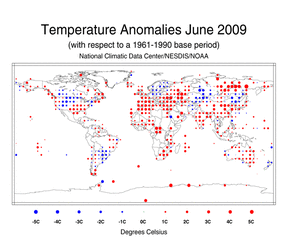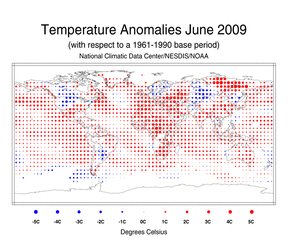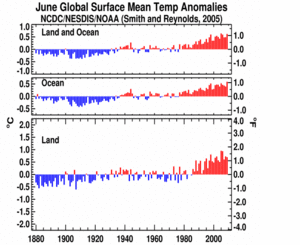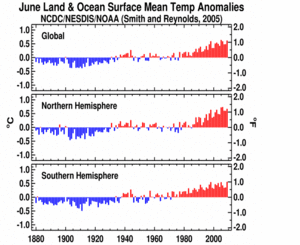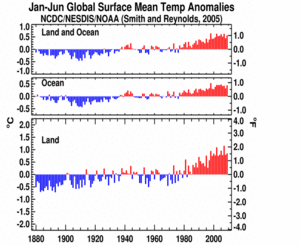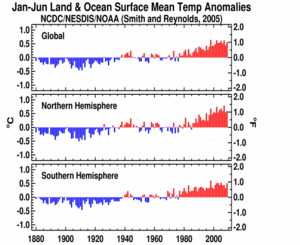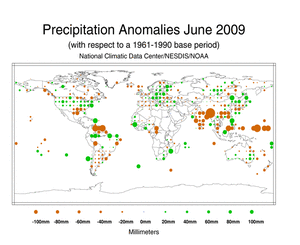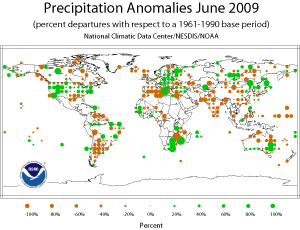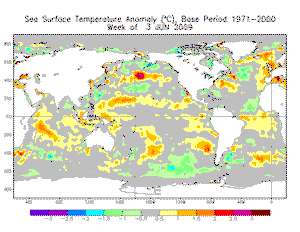Contents of this Section:
Global Highlights
- Based on preliminary data, the globally averaged combined land and sea surface temperature was the second warmest on record for June and the January-June year-to-date tied with 2004 as the fifth warmest on record.
- Large portions of each inhabited continent were substantially warmer than average during June 2009. The warmest anomalies were most notable in parts of Africa and most of Eurasia. The most notable cooler-than-average temperatures were present from the southwestern U.S. to the Northern Plains, the Canadian Prairie Provinces, central Asia, and across the boundary of northeastern China and southeastern Russia.
- The most notable above-average precipitation during June 2009 was present across parts of central and northeastern Europe, eastern Asia, northern Brazil, and most of the northern half of the contiguous United States. The driest anomalies occurred across India, southeastern Asia, northern South America, southeastern and south central contiguous U.S., and parts of the western Pacific Islands.
- El Niño–Southern Oscillation (ENSO) transitioned from ENSO-neutral to El Niño conditions across the equatorial Pacific Ocean during June 2009. If El Niño conditions continue to mature as projected by NOAA, global temperatures are likely to continue to threaten previous record highs.
The data presented in this report are preliminary. Ranks and anomalies may change as more complete data are received and processed. The most current data may be accessed via the Global Surface Temperature Anomalies page.
Introduction
Please Note: Beginning with the July 2009 State of the Climate Report, NCDC will switch to a new version (version 3b) of the extended reconstructed sea surface temperature (ERSST) dataset. ERSST.v3b is an improved extended SST reconstruction over version 2. Most of the improvements are justified by testing with simulated data. The primary difference in version 3b, compared to version 2, is improved low-frequency tuning that increases the sensitivity to data prior to 1930. In ERSST v3b, satellite data was removed from the ERSST product. The addition of satellite data from 1985 to present caused problems for many users. Although the satellite data were corrected with respect to the in situ data, a small residual cold bias remained at high southern latitudes where in situ data were sparse. For more information about the differences between ERSST.v3b and ERSST.v2 please read Summary of Recent Changes in the Land-Ocean Temperature Analyses and Improvements to NOAA's Historical Merged Land-Ocean Surface Temperature Analysis (1880-2006) paper.
Temperature anomalies for June 2009 are shown on the dot maps below. The dot map on the left provides a spatial representation of anomalies calculated from the Global Historical Climatology Network (GHCN) dataset of land surface stations using a 1961-1990 base period. The dot map on the right is a product of a merged land surface and sea surface temperature (SST) anomaly analysis developed by Smith and Reynolds (2005). Temperature anomalies with respect to the 1961-1990 average for land and ocean are analyzed separately and then merged to form the global analysis. Additional information on this product is available.
Large portions of each inhabited continent were substantially warmer than average during June 2009. Above-average temperatures were observed across Africa, Australia, eastern Brazil, south central and southeastern contiguous U.S., Alaska's panhandle, western Alaska, western Canada, and most of Europe and Asia. The most notable warmer-than-average temperatures were recorded across parts of Africa and most of Eurasia, where temperatures were 3°C (5°F) or more above average. Cooler-than-average conditions were present across Scandinavia, parts of the southwestern U.S. to the Northern Plains, the northeastern U.S., the Canadian Prairie Provinces, southern South America, central Asia, and across the boundary of northeastern China and southeastern Russia.
Sea surface temperatures during June 2009 were warmer than average across much of the world's oceans, with the exception of cooler-than-average conditions across the southern oceans. The global ocean SST for June 2009 was the warmest on record, 0.59°C (1.06°F) above the 20th century average of 16.4°C (61.5°F). This broke the previous June record set in 2005. Sea surface temperature anomalies in all Niño regions continued to warm during June 2009, where the monthly temperatures were more than 0.5°C (0.9°F) above average. If El Niño conditions continue to mature as projected by NOAA, global temperatures are likely to continue to threaten previous record highs. Please see the June 2009 ENSO discussion for additional information.
The January-June 2009 map of temperature anomalies shows the presence of warmer-than-average conditions across much of the world's land areas, with the exception of cooler-than-average temperatures across Canada. Sea surface temperatures were warmer than average across the North Indian and western Pacific oceans, and most of the Atlantic Ocean. Cooler-than-average SSTs were present across the central equatorial Pacific Ocean, along the western coasts of North America and northwestern Africa, and across most of the southern oceans.
The average position of the upper-level ridges of high pressure and troughs of low pressure (depicted by positive and negative 500-millibar height anomalies on the June 2009 map, respectively) are generally reflected by areas of positive and negative temperature anomalies at the surface, respectively. For other Global products, please see the Climate Monitoring Global Products page.
Images of sea surface temperature conditions are available for all weeks during 2009 from the weekly SST page.
Temperature Rankings and Graphics
The combined global land and ocean surface temperature was the second warmest on record in June, behind 2005, and tied with 2004 as the fifth warmest on record for the year-to-date (January-June) period. The global ocean had the warmest June on record. The ranks found in the tables below are based on records that began in 1880.
| June | Anomaly | Rank (out of 130 years) |
Warmest (or Next Warmest) Year on Record |
|---|---|---|---|
GlobalLandOcean Land and Ocean |
+0.70°C (+1.26°F) +0.59°C (+1.06°F) +0.62°C (+1.12°F) |
6thwarmest warmest 2nd warmest |
2005 (+0.95°C/1.71°F) 2005 (+0.53°C/0.95°F) 2005 (+0.64°C/1.15°F) |
Northern HemisphereLandOcean Land and Ocean |
+0.72°C (+1.30°F) +0.65°C (+1.17°F) +0.67°C (+1.21°F) |
7th warmest warmest 3rd warmest |
2006 (+1.13°C/2.03°F) 2005 (+0.62°C/1.12°F) 2006 (+0.74°C/1.33°F) |
Southern HemisphereLandOcean Land and Ocean |
+0.63°C (+1.13°F) +0.55°C (+0.99°F) +0.56°C (+1.01°F) |
5th warmest warmest warmest |
2005 (+1.12°C/2.02°F) 1998 (+0.51°C/0.92°F) 2005 (+0.55°C/0.99°F) |
| January- June |
Anomaly | Rank (out of 130 years) |
Warmest Year on Record |
|---|---|---|---|
GlobalLandOcean Land and Ocean |
+0.85°C (+1.53°F) +0.44°C (+0.79°F) +0.55°C (+0.99°F) |
5th warmest 6th warmest 5th warmest |
2007 (+1.16°C/2.09°F) 1998 (+0.53°C/0.95°F) 1998 (+0.64°C/1.15°F) |
Northern HemisphereLandOcean Land and Ocean |
+0.90°C (+1.62°F) +0.40°C (+0.72°F) +0.59°C (+1.06°F) |
9th warmest 7th warmest 6th warmest |
2007 (+1.36°C/2.45°F) 2005 (+0.51°C/0.92°F) 2007 (+0.79°C/1.42°F) |
Southern HemisphereLandOcean Land and Ocean |
+0.67°C (+1.21°F) +0.48°C (+0.86°F) +0.51°C (+0.92°F) |
4th warmest 3rd warmest 4th warmest |
2005 (+0.95°C/1.71°F) 1998 (+0.56°C/1.01°F) 1998 (+0.60°C/1.08°F) |
The most current data may be accessed via the Global Surface Temperature Anomalies page.
Precipitation
The maps below represent anomaly values based on the GHCN dataset of land surface stations using a base period of 1961-1990. During June 2009, above-average precipitation fell over areas that included central and northeastern Europe, southeastern Australia, parts of central Russia, eastern Asia, northern Brazil, and most of the northern half of the contiguous United States. The driest anomalies occurred across India, southeastern Asia, northern South America, southeastern and south central contiguous U.S., and parts of the western Pacific Islands.
Notable precipitation extremes during June 2009 include the heavy downpours that fell over central Europe, triggering mudslides, producing floods, and prompting rivers to burst their banks. According to reports, this was central Europe's worst natural disaster since the 2002 floods that claimed 17 lives and caused nearly $3 billion in repair costs.
India and its surrounding countries had well-below-average precipitation during June 2009, mainly due to the late arrival of the monsoon (the monsoon typically arrives about June 1st). According to India's Press Information Bureau, the country as a whole received a total of 102.9 mm (4.1 inches) of rain during June 1st to July 2nd, which is 43 percent below its long term average. The monsoon rains are crucial for the region's farming sector.
Additional details on flooding and drought can also be found on the June 2009 Global Hazards page.
ENSO SST Analysis
As shown in the adjacent animation, SST continued to warm across the equatorial Pacific during June 2009, resulting in anomalies greater than 0.5°C (0.9°F) above average in all Niño regions, indicating a transition from neutral-ENSO conditions to El Niño conditions. A comprehensive summary of June 2009 ENSO conditions can be found on the ENSO monitoring page. For the latest advisory on ENSO conditions, please visit NOAA's Climate Prediction Center (CPC) and the CPC ENSO Diagnostic Discussion.
Images of sea surface temperature conditions are available for all weeks since 2003 at the weekly SST page.
References
Peterson, T.C. and R.S. Vose, 1997: An Overview of the Global Historical Climatology Network Database. Bull. Amer. Meteorol. Soc., 78, 2837-2849.
Quayle, R.G., T.C. Peterson, A.N. Basist, and C. S. Godfrey, 1999: An operational near-real-time global temperature index. Geophys. Res. Lett., 26, 333-335.
Smith, T.M., and R.W. Reynolds (2005), A global merged land air and sea surface temperature reconstruction based on historical observations (1880-1997), J. Clim., 18, 2021-2036.
 NOAA's National Centers for Environmental Information
NOAA's National Centers for Environmental Information
